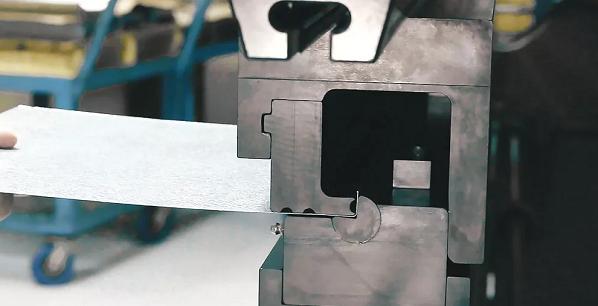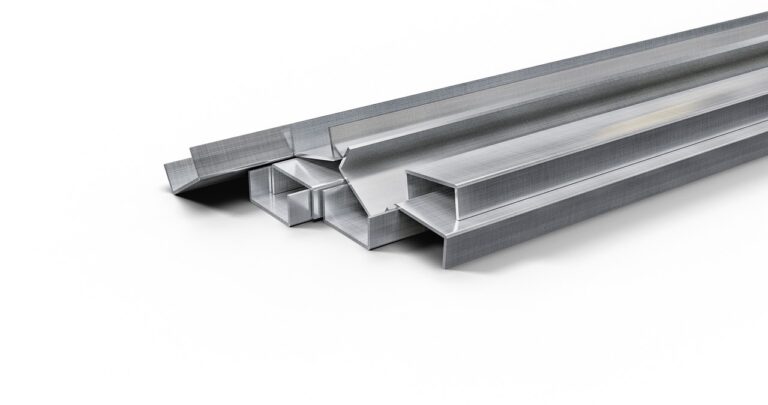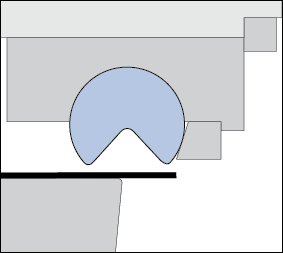Our Location
Aluminum bending is cost-effective and provides design flexibility and the capability to create complex desired shapes. However, not all aluminum and temper conditions apply equally to bending. Read the guidelines below before starting the projects.

Table of Contents
ToggleAluminum bending is a process of shaping flat aluminum profiles into curved or angular shapes. The process involves applying force to the profile and permanently deleting it into the desired shape. It is a popular method for creating custom shapes and designs from aluminum.
Aluminum’s strength, lightweight nature, and corrosion resistance allow it to bend without breaking or cracking easily.

Several factors influence the bending process for aluminum. Those factors greatly affect the quality of the bend and determine if the operation can be done successfully. Below are three key factors that affect the aluminum bending process:
One of the essential properties of aluminum is formability, which refers to its ability to bend without cracking or breaking. Aluminum alloys have good formability, making them ideal materials to bend. However, different aluminum alloys have different levels of formability, which can make some alloys more difficult to bend than others.
The thickness of the material also determines the degree of bending and the bending radius of the aluminum alloy. Thicker aluminum and smaller bend radii require more force, while thinner aluminum and larger bend radii are easier to bend.
The level of elongation refers to the extent to which aluminum can stretch before breaking. Aluminum alloys with higher elongation levels are generally easier to bend than lower levels of elongation.

Source: Buckling and bending properties of aluminum plate with multiple cracks
Regarding bending aluminum, the most suitable alloy series for forming are 3, 5, and 6. Avoid using alloys in the series 2 family, as they are solid and difficult to form. However, in the right temper, bending those alloys is also possible.
Out of the numerous options available, here are my top four picks for bending aluminum:
1. Aluminium alloy 3003: This is probably the best alloy for bending as it offers average strength, excellent cold workability, and one of the biggest differences between yield and tensile strength.
2. Aluminium alloy 5052: This alloy has high elongation, a solid difference between yield and tensile strength, high strength compared to other non-heat-treatable grades, and excellent corrosion behavior. When annealed, it beats the 3003 alloys in formability.
3. Aluminium alloy 5083: This alloy is a good choice for the marine industry due to its corrosion resistance and weldability. The choice of temper is crucial for its bending capabilities. Temper options such as H111, H112, or O temper are recommended.
4. Aluminium alloys 6061 and 6082: These are versatile heat-treatable alloys with a big difference between yield and tensile strength and good elongation when annealed. However, their bending ability decreases when moved to T4 and T6 tempers. It is recommended to bend them in T4 condition and then heat treat to T6 if possible.
It is important to note that the material’s grain structure also affects its bending capabilities, although grain structure affects other processes besides bending.

The aluminum alloy’s mechanical properties can be changed through tempering. To understand tempering, you need to know the following indicators:
– ‘T’ denotes thermal treatment
T6 and T651 tempers in the 6xxx series are strong and moderately formable, ideal for applications that need strength and flexibility. But be cautious when bending to avoid cracking due to reduced ductility.
– ‘H’ denotes the alloy has been hardened
H tempers strengthen aluminum through plastic deformation. H14 and H24 are popular for bending with moderate angles without cracking.
– ‘O’ denotes the aluminum has been annealed
O-temper aluminum is annealed, which makes it highly formable for simple bending operations. It may lack the strength for more complex bends or structural applications.
– ‘F’ denotes the alloy has undergone fabrication
Aluminum alloys are available in different tempers, from soft to hard. Also, softer-tempered aluminum alloys tend to spring back more than hard-tempered ones.
Aluminum sheets often break after the bending process, especially after anodizing. It often confuses aluminum alloy processing suppliers; how do you bend aluminum without damaging it? Here are 8 main preventive measures that need to be considered.
1. Use aluminum sheets with a suitable grade and condition.
2. Using the correct metal bending equipment
3. Increase the bending R angle as much as possible.
4. Fill the curved portion of the cavity with filler to avoid depression.
5. Prevent cracks by improving the cross-sectional area or adjusting the tension.
6. Adjust the mold gap and improve the mold material to prevent scratches.
7. Use gentle curves instead of sharp bends to reduce stress.
8. Apply lubricant to reduce force and prevent cracking
Efficient and reliable techniques for bending aluminum depend on the material cross-section. Whether you need to bend an aluminum sheet, tube, or bar, there are various options. To ensure successful bending, choosing the most appropriate technique for the specific material you are working with is crucial.
Roll bending is a process that is commonly used to shape aluminum into a desired form. The process involves positioning the aluminum between two rolls and setting the desired bend angle and depth. Once the roll bending machine is activated, the aluminum is passed through the rolls, which apply pressure and bend the aluminum accordingly. This method is efficient for shaping aluminum into a variety of shapes.
Roll bending aluminum offers several benefits, including fast and consistent results and the ability to bend large, thick pieces of aluminum. However, this process needs special equipment. It is costly.
To shape aluminum, a press brake machine applies mechanical force.
1. the operator positions the aluminum between the punch and die.
2. Set the desired bend angle and depth before activating the press brake machine.
3. the punch applies pressure to the aluminum, causing it to bend around the die.
Press brake bending is fast and precise and produces consistent, high-quality bends. This method is also suitable for bending large, thick pieces of aluminum. But, it is expensive because of the special equipment. Furthermore, it may only be suitable for a small or thin piece of aluminum.
Push Bending is an aluminum bending process that involves using a ram or push tool to apply mechanical force to the aluminum. The operator starts by positioning the aluminum in a jig or fixture and then activates the ram or push tool. The tool applies pressure to the aluminum, bending it into the desired shape. This process is effective for producing aluminum with tight bends, but may not be suitable for large or thick pieces of aluminum.
Rotary bending is a method used to bend aluminum by applying mechanical force with a rotary draw bender. The process involves positioning the aluminum between a mandrel and a die and activating the rotary draw bender. The mandrel applies pressure to the aluminum, bending it around the die.
The benefits of rotary draw bending aluminum include producing tight radii, accurate angles, and smooth transitions. Additionally, this method is suitable for bending large, thick aluminum pieces.
However, rotary draw bending aluminum requires specialized equipment, which is expensive to purchase and operate.

Source: WorldAutuSteel
Aluminum can be bent through a process known as compression bending. This method involves using a punch and die to apply mechanical force on the aluminum, resulting in a bend. An operator positions the metal between the punch and die to compression bend aluminum and activates the compression bending machine. The punch applies pressure on the aluminum, bending it around the die. It allows the creation of aluminum products with identical bends on both sides. However, It is expensive to get the equipment.
Aluminum stretch forming is a process that involves using mechanical force to bend and shape aluminum into the desired form. To begin, the operator places the aluminum in a jig or fixture before activating the stretch-forming machine. The jig or fixture then applies pressure to stretch the aluminum into the desired shape. It allows us to replicate the angle of the bend. At the same time, the tension during the process ensures that you have constant control over the entire length of the aluminum piece. However, the equipment is expensive.
Aluminum can be bent by hand using simple tools like pliers or hammers. The operator first positions the aluminum in the desired shape and applies force using the hand tools. This process is simple, inexpensive, and suitable for small or thin aluminum pieces. However, it can be slow and may not work well for large or thick aluminum pieces. Additionally, since the method is inconsistent, the final output may vary in appearance.
Aluminum can be shaped using the three-roller bending method. To do this, the aluminum is placed between three rollers, and the machine is activated. The rollers apply pressure to the aluminum and bend it into the desired shape. This process is suitable for creating architectural components and for construction projects. However, the weak point is that special equipment is expensive.

Source: Three-Roller Bending
Aluminum is a malleable material that can be easily formed into desired shapes. Once shaped, the sheet or profile retains its form permanently, provided the bending process was executed correctly.
The choice of aluminum bending technique depends on many factors, such as the part’s design, raw material, budget, quality requirements, and production deadlines. We hope the guidelines have provided insight into the aluminum bending process. Please Contact Us for any aluminum bent parts from China.

